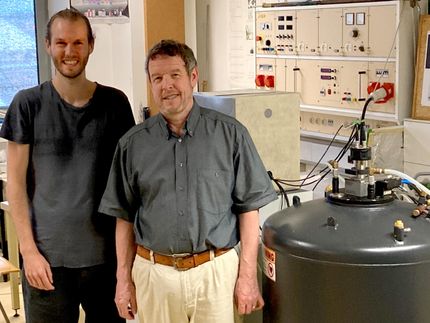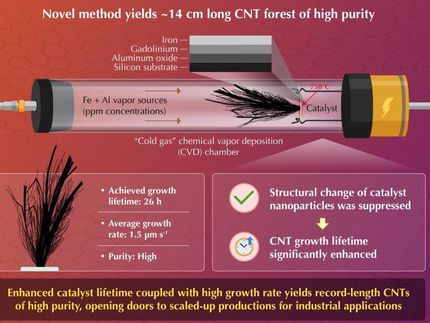First result from a new generation of reactor neutrino experiments
Physicists of the Double Chooz experiment detected a short-range disappearance of electron antineutrinos. They presented this result on Wednesday 9 November 2011 at the LowNu conference in Seoul, Korea. It helps determine the so-far unknown third neutrino mixing angle which is a fundamental property with important consequences for particle and astro-particle physics. The Double Chooz experiment is looking for neutrinos produced in the nearby nuclear power plant. A measurement of this third angle would complete our picture of neutrino oscillations as reported by other experiments and will open new perspectives in understanding why we find matter and no antimatter in our today’s Universe.
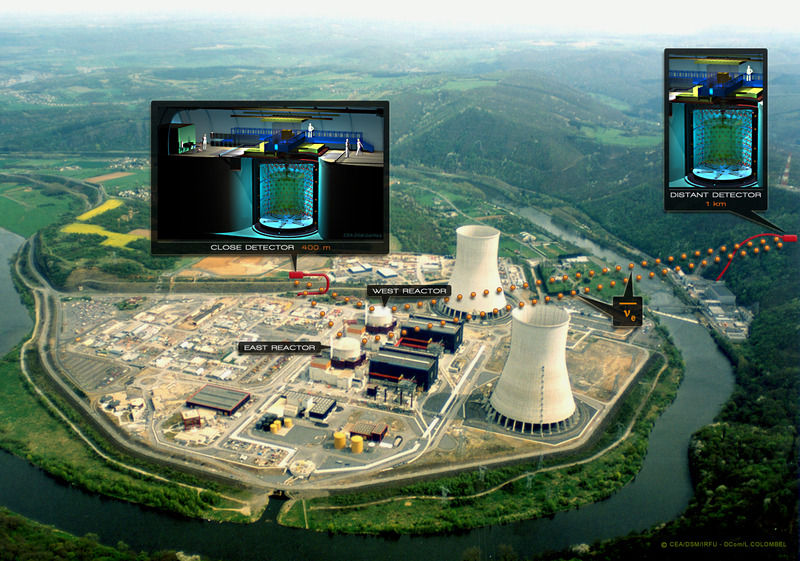
Overview of the Double Chooz experiment with the nuclear power plant and the two detectors.
Double Chooz Collaboration

Photomultipliers inside the Double Chooz detector.
Double Chooz Collaboration
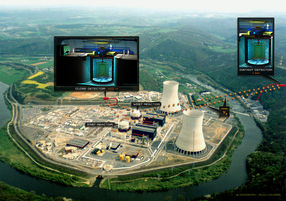
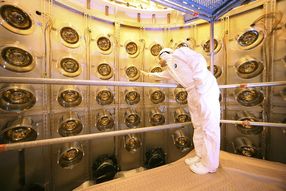
Neutrinos are the most common particles existing in the Universe, but they are the least visible. They exist in three kinds called “flavours” and they have been known since the late 90’s for their special ability to transform from one type into another. This phenomenon is called neutrino oscillation and it implies that neutrinos do have a mass. Neutrino oscillations are currently an intensive field of research with several experiments aiming at a full description of the mechanism.
Neutrinos are produced in various ways such as by fusion processes inside the Sun and by cosmic rays bombarding the atmosphere. The Double Chooz experiment is dedicated to measure neutrino oscillations with unprecedented precision, by looking at anti-neutrinos being produced in the nearby nuclear reactor at Chooz in the French Ardennes. Double Chooz started taking data six months ago. At the 2011 LowNu conference in Korea the collaboration just announced its first results, reporting new data consistent with short-range oscillations. This result is based on the observation of the “disappearance” of (anti-)neutrinos in the expected flux observed from the nuclear reactor.
The three different flavours of neutrinos are related to their charged lepton counterparts: electron, muon and tau. Oscillations depend on three mixing parameters, of which two are large and have been measured before. The third mixing angle called θ_13 (theta13) was not well measured up to now and restricted by an upper limit. The Double Chooz collaboration, by measuring the “disappearance” of electron antineutrinos, presents hints for oscillation also involving the third angle with the following value: sin^2(2θ_13) = 0.085 ± 0.051. The probability given by preliminary results that there is no oscillation is only 7.9%.
The measurement of the last mixing angle θ_13 (theta13) is crucial for future experiments aimed at measuring the difference between neutrino and anti-neutrino oscillations (leptonic CP violation). Furthermore, it relates indirectly to the origin of the asymmetry between matter and antimatter in the Universe.
“The third mixing angle is currently the missing link of neutrino physics. Measuring it precisely is the key to open the door to new physics beyond the standard model of particle physics and we are now very close to it” said Herve de Kerret from CNRS in France, and spokesman of the Double Chooz collaboration.
In June 2011, first hints of oscillation of neutrino muon neutrinos to neutrino electron neutrinos, involving this third angle, have been reported by accelerator experiments. The Double Chooz collaboration, by measuring the “disappearance” of electron antineutrinos, presents complementary and important evidence of oscillation also involving the third angle.
Double Chooz uses currently a detector located at a distance of about 1000 m from the reactor cores. The precision of the measurement will further increase over time and after the start of operation in 2012, of a second or “near” detector located at a distance of 400 m from the reactor. At these distances, no significant transformation into another neutrino species is expected. But by combining the results from both detectors, sin^2(2θ_13) can be determined with even higher precision.
The detector target is composed of 10 m^3 of liquid scintillator developed specifically for this experiment. The scintillator is doped with gadolinium in order to tag neutrons from inverse beta decays induced by the reactor anti-neutrinos. The target is surrounded by layers of other liquids protecting against other particles and environmental radioactivity. The target is observed by 390 immersed photomultipliers, converting the interactions into electronic signals. These signals are processed in a data acquisition system, which is ready to take data over the next five years. The new detectors will ensure that neutrino physics will stay one of the most fruitful areas of particle physics, as it has been for the past 50 years.
An essential contribution to the project was the development of the gadolinium-doped liquid scintillator by the researchers at the Max Planck Institute for Nuclear Physics in Heidelberg. Their task was to find, test, produce and purify a gadolinium compound which is solvable in an organic liquid and chemically stable for many years. In collaboration with their colleagues from Japan they checked the photomultipliers in a specially built testbed. These central contributions will also play a crucial role for the interpretation and data analysis.
The Double Chooz collaboration is composed of universities and research institutes from Brazil, England, France, Germany, Japan, Russia, Spain and the USA.
